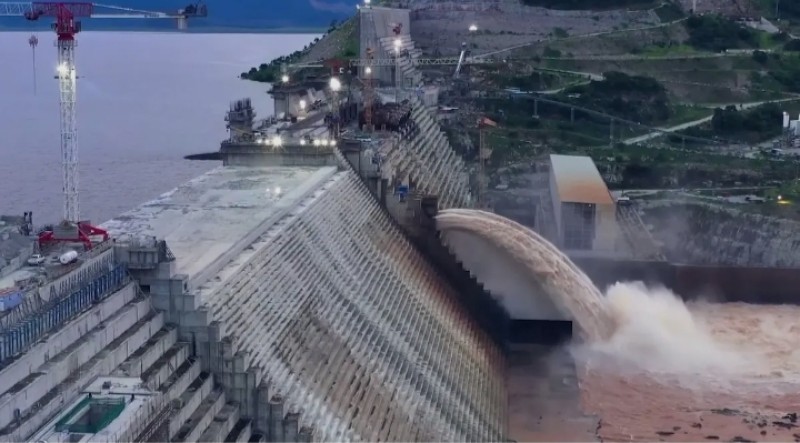”محمد سعد عبد اللطيف” يكتب :جيوسياسية الصراع والقوة بين الهند والصين وبحر الصين الجنوبي

تطورت جغرافية الصراعات المادية والجيوسياسية منذ نهاية الحرب العالمية الثانية، وظهور التحولات في طبيعة الصراع الأهلي والنظام العالمي إلى ثلاث فترات صعبة؛ تبدأ من عام 1946م إلی إنهیار الإتحاد السوفیيتي وسقوط حاٸط برلین في نهاية الربع الأخير من القرن المنصرم (الحرب الباردة)، ومرحلة ما بعد الحرب الباردة، ونظام العولمة، وتتطلع الصين إلي الصعود كقطب منافس للولايات المتحدة، مع إحياء مشروع طريق الحرير الجديد، وهيكلة الصين للعالم جيوسياسيًا.
ففي الماضي شيدت الصين سورها العظيم من أجل الإنعزال عن العالم، وهو تصور دفاعي قديم يلخص فلسفة هذا البلد العملاق من أجل الحفاظ على قيمه وأمنه في مواجهة الآخر. لكن الآن تشيد الصين أكبر جسر تجاري في العالم، يجعلها تتبوأ التجارة العالمية في وقت تتراجع فيه الولايات المتحدة، وتتبنى مفهوم السور المغلق مع إدارة ترامب السابقة؛ فالصين التي شيدت أكبر سور قديماً، الآن تشيد أكبر جسر تجاري عالمي يربط حوالي 70 دولة، وتعود الصين إلى تراثها وتاريخها، من أجل منح نفسها مكانة في مسرح جيوسياسي، بإحياء هذا الطريق في وقتنا الراهن، ويكون «طريق الحرير» الذي يُعد بداية نهاية الهيمنة الغربية على العالم، ولكن الأهمية الاستراتيجية، والموقع الجغرافي المهم لبحر الصين الجنوبي يعتبر ممرًا مهمًا عالميًا؛ حيث يعبر منه نصف التجارة العالمية!!! إن النزاعات الإقليمية في المحيط الجغرافي للصين، خاصة النزاع الحدودي بين الهند والصين في إقليم (دوكلام) أخذ شكلًا من المواجهات العسكرية، بعد أن ظل نصف قرن مناوشات بالعصا والأيادي، ليعيد عام 1962م إلي الذاكرة بهزيمه الهند. إن الوضع في هضبة التبت، والحدود الشاسعة التي تتجاوز 4000كم خلقت صراعًا في مملكة (بوتان) الحدودية المشكلة الرئيسية الآتية. كيف أسهمت موارد الطاقة في بحر الصين الجنوبي 《والجيوبوليتيك》في تحديد طبيعة التّفاعلات السياسية، ضمن هذا النّطاق الجغرافي المهم في الخريطة العالمية في بحر الصين الجنوبي؟! فالدول في هذا المحيط الإقليمي التي تُعد 9 دول تتنافس للسيطرة على البحر، بسبب وجود إمكانات نفطية وغازية في أعماقه، تؤهّله ليكون موازيًا للخليج العربي، من أهمية إقتصادية وسياسية وسياحية، والصراع الصيني مع دول الجوار علي أحقية الصين في الإستحواذ علي حوالي 80% من مساحة المياه الإقليمية للبحر. تعتمد الصين علي القرائن الجغرافية في ذلك الحق، وإصطفاف الهند مع الولايات المتحدة ضد الصين، يجعل النزاع الحدودي يأخذ شكلًا آخر في دولة “بوتان”، أو ما تعرف بدولة السعادة؛ تخلق وضعًا جديدًا بين صراع القوة الصاعدة في النظام العالمي الجديد. إن مملكة بوتان التي تقع في هضبة التبت أشعلت ملف النزاع الحدودي الملتهب بين الصين والهند في الماضي القريب في ستينيات القرن المنصرم، والذي ينفجر من حين لآخر سببًا من ضمن أسباب التوتر المستمر في العلاقات بين البلدين، والذي أدى إلى انفجار الوضع بينهما العام قبل الماضي، بعد أن تدخلت قوات الحدود الهندية لإيقاف المهندسين الصينيين عن الاستمرار في بناء طريق في منطقة «دوكلام»، التي تتنازع عليها “مملكة بوتان والصين”!!! ومع صعود التنين الصيني في الصراع العالمي كقوة اقتصادية وسياسية تفرض نفسها البديل عن الولايات المتحدة بعد “جائحة كوفيد 19” كقطب منافس، وفرض الأمر الواقع علي الأرض، مع مشروع طريق الحرير الجديد، والصراع أو الحرب غير المعلنة مع أمريكا، أو ما يعرف بالحرب التجارية!!! تحاول الاستخبارات الأمريكية فتح ملفات شائكة جيوسياسية مع منافس صاعد موالي لسياسات الولايات الأمريكية مع جيران للصين، وجعلها مناطق صراع وتوتر في العلاقات، خاصة مع “قوتين نوويتين”، وأكبر عدد من الديمٌغرافيا في العالم كذلك باكستان؛ التي انحازت اخيرًا للصين بعد تخلي السعودية عن مساعدتها في قرض مالي، جاءت الصين تعرض مساعدتها لباكستان العدو للهند، والوضع في شرق الصين من المسلمين، وزعزعة نسيج المجتمع الصيني؛ تلعب امريكا في خلق دور للإسلام السياسي في المناطق الإسلامية ضد الأيديولوجية للصين، ومن المعروف أن الهند تدعم مطالبات «بوتان» في هذه المنطقة القريبة، وقد《آوت الزعيم الروحي لهضبة التبت》.
وإن الأرض الهندية المتنازع عليها تُعرف باسم «رقبة الدجاجة»، ولكن منطقة «دوكلام»، ظهرت مرة أخرى كموضوع للنزاع بين البلدين، وذلك عندما واصلت الصين الإجراءات الرامية إلى تعزيز وجودها، وقدراتها الدفاعية في هذه المنطقة، وبدأ صراع التسلح في بناء قواعد جوية وعسكرية علي طرفي حدود النزاع، ومع دخول الهند عضو في تشكيل《المجموعة الرباعية》، التي تتكون منها، ومن الولايات المتحدة الأمريكية، واليابان، وأستراليا، والدول الأربع في المجموعة تشعر بنفس القدر من القلق تجاه الصعود الصيني .
كما أن الصين ترى من جانبها أن هذا التجمع الرباعي يضر بمصالحها، وأنه قد أنشئ في الأساس من أجل احتواء نموها، مما يجعل الصراع قائمًا، وكذلك وجود صراع القوى الإقليمية في بحر الصين الجنوبي، فإن للولايات المتحدة الأمريكية لها مصالحها (جيوبوليتيكية) في هذا البحر، باعتمادها الأساسي في حرية الملاحة فيه للسفن الأمريكية التي تجوب نطاقه، لأغراض تجارية وعسكرية، إضافة إلى تأمين السفن دون تحويل هذا البحر إلى مجال حيوى للمصالح الصينية فحسب، هذا فضلًا عن الرغبة في توظيف نقاط الضّعف الجغرافية فيه عبر التّحكم في المضائق التّي تحيط به، سواء من طريق نشر القواعد العسكريّة، أو من طريق التحالف مع القوى الصَّديقة لأمريكا المطلّة عليه !!! لذلك من المعروف أن الهند قد عملت بسبب تنامي الطموحات الصينية على توطيد أواصر العلاقات بينها وبين الولايات المتحدة التي تنظر إلى الهند كدولة يمكن أن تكون قادرة على مواجهة واحتواء الصين؛فليس هناك مقارنة بين الصين والهند من صراع القوة، فالصين ناتجها القومي بالنسبة لناتج الهندي خمس أضعاف الناتج الهندي، كذلك القوة العسكرية؛ فعلى سبيل المثال، تدعي الصين ملكيتها لولاية (أروناشال براديش) الواقعة شمال شرقي الهند بكاملها، وتعتبرها جزءًا من أراضيها، وفي الوقت الذي تندلع فيه النزاعات الحدودية بين البلدين من وقت لآخر، إلا أن البلدين توصلا في عام 1962م بعد الحرب إلي هدنة بعد مؤتمر باندونج لدول عدم الإنحياز إلي تهدئة الأوضاع فقط، ولم تستطع حل النزاع، وفي التسعينيات من القرن المنصرم إلى قرار بعدم السماح لتلك النزاعات حول الحدود بالتأثير على المجالات الأخرى في منظومة العلاقات بينهما، وهو ما كان له تأثير في نمو العلاقات الاقتصادية بين البلدين إلى الدرجة التي باتت فيها الصين أكبر شريك تجاري للهند .
ومع ذلك يمكن القول إن اشتعال الوضع في «دوكلام»، يُعد واحدة من أكثر الأزمات الحدودية التي نشأت بين البلدين من حيث درجة الخطورة، ومع أن الهند قد أعلنت حينها أن النزاع قد جرى حله، إلا أن المحللين خلصوا إلى أنه لم ينته بعد، بدليل أن نيودلهي ما زالت تصر على أنه من الضرورى عدم تغيير «الوضع القائم» فى النقاط الحساسة على الحدود بين البلدين، في حين تصر الصين على تحسين البنية التحتية في هذه النقاط.
ويمكن القول مع ذلك إن أنشطة الصين على أرض «دوكلام» تدل على مدى ثقة الصين بقوتها الآخذة في التعاظم في آسيا، كما يمكن أن تكون رد فعل من جانبها على التقارب الهندي- الأمريكى، ومع كل ذلك اين نحن العرب من الهيمنة الصينية من الجيوسياسية للعالم ؟
The geography of material and geopolitical conflicts has evolved since the end of the Second World War, and the emergence of shifts in the nature of civil conflict and the global system into three difficult periods; Starting from 1946 AD to the collapse of the Soviet Union and the fall of the Berlin Wall at the end of the last quarter of the last century (the Cold War), the post-Cold War era, and the system of globalization, and China is looking to rise as a pole competing with the United States, with the revival of the New Silk Road project, and the restructuring of China To the world geopolitically. In the past, China built its Great Wall in order to isolate itself from the world, an ancient defensive conception that summarizes the philosophy of this giant country in order to preserve its values and its security in the face of the other. But now China is building the largest trade bridge in the world, making it enter global trade at a time when the United States is retreating and adopting the concept of a closed wall with the previous Trump administration. China, which built the largest ancient wall in the past, is now building the largest global trade bridge linking about 70 countries, and China returns to its heritage and history, in order to give itself a place in a geopolitical theater, by reviving this road at the present time, and the "Silk Road" which is the beginning of the end of hegemony West to the world, but the strategic importance, and the important geographical position of the South China Sea is considered a globally important corridor; Half of the world trade passes through it !!! The territorial disputes in the geographical perimeter of China, especially the border dispute between India and China in the Doklam region, took the form of military confrontations, after half a century of skirmishes with the stick and hands, to return the year 1962 AD to memory of his defeat of India. The situation on the Tibetan plateau, and the vast borders of more than 4000 km created a conflict in the (Bhutan) frontier kingdom the following main problem. How did the energy resources in the South China Sea and geopolitics》 contribute to determining the nature of political interactions, within this important geographical area on the global map in the South China Sea ?! Countries in this regional environment that are 9 countries are competing for control of the sea, due to the presence of oil and gas capabilities in its depths that qualify it to be parallel to the Arab Gulf, due to economic, political and tourism importance, and the Chinese conflict with neighboring countries over China's right to acquire about 80% of the area The territorial waters of the sea. China relies on geographical evidence in that right, and India’s alignment with the United States against China makes the border dispute take another form in the state of "Bhutan", or what is known as the state of happiness It creates a new situation between the rising power struggle in the new world order. The Kingdom of Bhutan, which is located on the Tibetan plateau, ignited the fiery border dispute between China and India in the recent past in the sixties of the last century, which explodes from time to time, one of the causes of the continuing tension in relations between the two countries, which led to the explosion of the situation between them the year before last, After the Indian border forces intervened to stop the Chinese engineers from continuing to build a road in the "Doklam" region, which "the Kingdom of Bhutan and China" is contesting !!! With the rise of the Chinese dragon in the global conflict as an economic and political power that imposes itself as an alternative to the United States after the "Covid 19 pandemic" as a rival pole, imposing a fait accompli on the ground, with the new Silk Road project, and the undeclared conflict or war with America, or what is known as the trade war !!! The US intelligence is trying to open geopolitical thorny files with a rising competitor loyal to the policies of the US states with neighbors to China, and make them areas of conflict and tension in relations, especially with “two nuclear powers” and the largest number of demographics in the world as well as Pakistan; China has finally sided with China after Saudi Arabia abandoned its aid in a financial loan. China offered its aid to Pakistan, the enemy of India, the situation in eastern China from Muslims, and shaken the fabric of Chinese society; America is playing in creating a role for political Islam in the Islamic regions against the ideology of China. It is known that India supports the claims of "Bhutan" in this nearby region, and "has sheltered the spiritual leader of the Tibetan plateau"; The disputed Indian land is known as the "chicken neck", but the "Doklam" area emerged again as a subject of conflict between the two countries, when China continued measures aimed at strengthening its presence and defense capabilities in this region, and the arms struggle began to build air and military bases. On both sides of the borders of the conflict, and with the entry of India as a member in the formation of the "Quartet", which consists of it, and from the United States of America, Japan, Australia, and the four countries in the group feel the same amount of concern about the Chinese rise !!! China also believes, for its part, that this quadripartite grouping is detrimental to its interests, and that it was established mainly in order to contain its growth, which makes the conflict exist, as well as the existence of the regional powers struggle in the South China Sea, the United States of America has its (geopolitical) interests in this sea. By its fundamental dependence on freedom of navigation therein for American ships that roam its range, for commercial and military purposes, in addition to securing ships without turning this sea into a vital area for Chinese interests alone, in addition to the desire to employ its geographical weaknesses by controlling the straits surrounding it, Either by deploying military bases, or by allying with the friendly forces of America overlooking it !!! Therefore, it is known that India has worked, due to the growing Chinese ambitions, to consolidate relations between it and the United States, which views India as a country that can confront and contain China. There is no comparison between China and India from the power struggle, as China is its national product in relation to the Indian product. Times the Indian output, so is the military power; For example, China claims ownership of the entire state of (Arunachal Pradesh) in north-eastern India, and considers it part of its territory, and while border disputes between the two countries erupt from time to time, the two countries reached an armistice in 1962 after the war after the Bandung Conference. The non-aligned countries have only to calm the situation, and were unable to resolve the conflict, and in the 1990s of the last century a decision not to allow those disputes over borders to affect other areas in the system of relations between them, which had an impact on the growth of economic relations between the two countries to the point that it has become China is India's largest trading partner !!! Nevertheless, it can be said that the flare-up of the situation in Doklam is one of the most dangerous border crises that have arisen between the two countries, and although India announced at the time that the dispute had been resolved, analysts concluded that it was not over yet, as evidenced by New Delhi still insists that it is necessary not to change the "status quo" in sensitive points on the border between the two countries, while China insists on improving the infrastructure at these points. It can be said, however, that China's activities on the land of "Doklam" indicate the extent to which China has confidence in its growing power in Asia. It could also be a reaction on its part to the Indian-American rapprochement, and with all that, where are we Arabs from the Chinese hegemony from the geopolitical world of the world?























